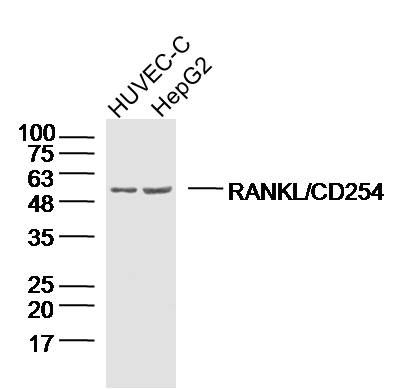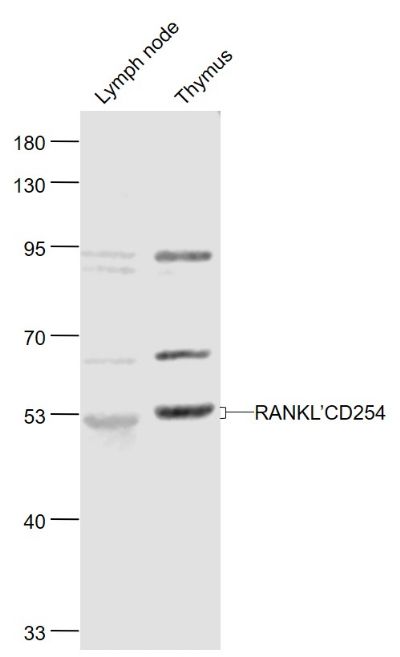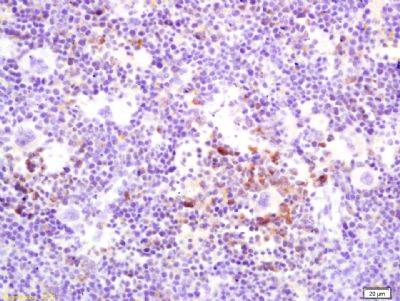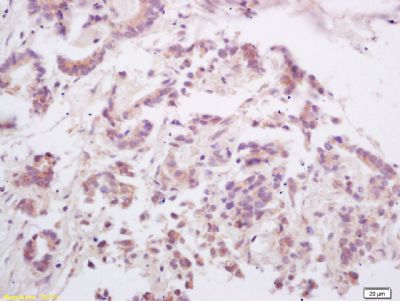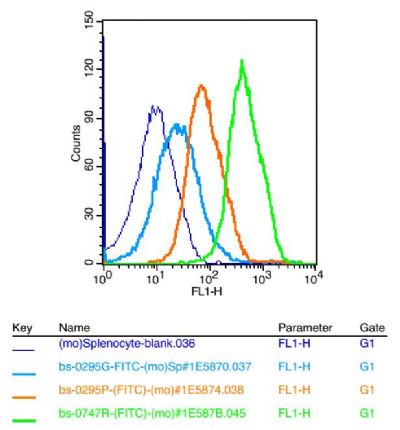[IF=2.84] Ota, Takehiro, et al. "Expression of colony-stimulating factor 1 is associated with occurrence of osteochondral change in pigmented villonodular synovitis."Tumor Biology (2015): 1-7. IHSLCP ; Human.
[IF=1.69] Dolci, Gabriel Schmidt, et al. "Atorvastatin-induced osteoclast inhibition reduces orthodontic relapse." American Journal of Orthodontics and Dentofacial Orthopedics 151.3 (2017): 528-538. IHSLCP ; Rat.
[IF=3.998] Daisuke Nishida. et al. RANKL/OPG ratio regulates odontoclastogenesis in damaged dental pulp. Sci Rep-Uk. 2021 Feb;11(1):1-12 IHC ; Mouse.
[IF=2.985] Yumi Sakamoto. et al. High-mobility group box 1 induces bone destruction associated with advanced oral squamous cancer via RAGE and TLR4. Biochem Bioph Res Co. 2020 Oct;531:422 WB,IHC ; Mouse.
[IF=3.906] Qiusheng Shan. et al. Significance of cancer stroma for bone destruction in oral squamous cell carcinoma using different cancer stroma subtypes. Oncol Rep. 2022 Apr;47(4):1-13 IHC ; Mouse.
[IF=5.923] Nanami Nakamura. et al. Possible Action of Olaparib for Preventing Invasion of Oral Squamous Cell Carcinoma In Vitro and In Vivo. Int J Mol Sci. 2022 Jan;23(5):2527 WB ; Mouse.
[IF=3.24] Hiroki Ehara. et al. Role of tissue factor in delayed bone repair induced by diabetic state in mice. Plos One. 2021 Dec;16(12):e0260754 WB ; Mouse.
[IF=0.343] Shunichiro Matsuoka. et al. Undifferentiated Pleomorphic Sarcoma of Soft Tissue with Multinucleated Giant Cells with Osteogenic Phenotypes: A Mimicker of Malignant Giant Cell Tumor of Soft Tissue. 2021 Jul 21 IHC ; Human.
[IF=1.813] Wang Tong. et al. Acupotomy Contributes to Suppressing Subchondral Bone Resorption in KOA Rabbits by Regulating the OPG/RANKL Signaling Pathway. Evid-Based Compl Alt. 2021;2021:8168657 WB,IHC ; Rabbit.
[IF=2.304] Teng X et al. Effects of Low Dietary Phosphorus on Tibia Quality and Metabolism in Caged Laying Hens. Prev Vet Med
. 2020 Aug;181:105049. WB ; Hen.
[IF=2.048] Yu X et al. Substance P aggravates periodontitis by upregulating HIF-1α and RANKL/OPG ratio. BMC Oral Health. 2019. WB ; Rat&Mouse.
[IF=1.984] Chen Y et al. Moxibustion of Zusanli (ST36) and Shenshu (BL23) Alleviates Cartilage Degradation through RANKL/OPG Signaling in a Rabbit Model of Rheumatoid Arthritis. Evid Based Complement Alternat Med. 2019 Jan 3;2019:6436420. IHSLCP ; Rabbit.
[IF=2.959] Peng W et al.Expression of osteoprotegerin and receptor activator for the nuclear factor-κB ligand in XACB/LSLVbFGF/MSCs transplantation for repair of rabbit femoral head defect necrosis.(2018) J. Cell. Biochem. Oct 18 WB ; Rabbit.
[IF=2.412] Yu X et al. CGRP gene-modified rBMSCs show better osteogenic differentiation capacity in vitro.J Mol Histol. 2018 Aug;49(4):357-367. WB ; Rat.
[IF=1.75] Chen, Helin, et al. "Intermittent administration of parathyroid hormone ameliorated alveolar bone loss in experimental periodontitis in streptozotocin-induced diabetic rats." Archives of Oral Biology (2017). IHSLCP ; Rat.
[IF=2.09] Chen, Zhiguang, et al. "Curcumin alleviates glucocorticoid-induced osteoporosis through the regulation of the Wnt signaling pathway."International Journal of Molecular Medicine. WB ; Rat.
[IF=2.38] Zhu, Wenjing, et al. "Effect of PI3K/Akt Signaling Pathway on the Process of Prostate Cancer Metastasis to Bone." Cell Biochemistry and Biophysics (2015): 1-7. WB ; Human.
[IF=1.98] Yu, Xijiao, et al. "Expression of neuropeptides and bone remodeling-related factors during periodontal tissue regeneration in denervated rats." Journal of Molecular Histology: 1-9. WB ; Rat.
[IF=1.88] Li, Xianxian, et al. "Oral administration of 5-Hydroxytryptophan aggravated periodontitis-induced alveolar bone loss in rats." Archives of Oral Biology(2015). IHSLCP ; Rat.
[IF=0.94] Zhang, Yuanyu, et al. "Mycobacterium tuberculosis 10-kDa co-chaperonin regulates the expression levels of receptor activator of nuclear factor-κB ligand and osteoprotegerin in human osteoblasts." Experimental and Therapeutic Medicine. WB ; Human.
[IF=2.68] Xiao, Wanan, et al. "Bone fracture healing is delayed in splenectomic rats." Life Sciences (2016). WB ; Rat.
[IF=3.08] Zhan, Fu‐Liang, Xin‐Yang Liu, and Xing‐Bo Wang. "The Role of MicroRNA‐143‐5p in the Differentiation of Dental Pulp Stem Cells into Odontoblasts by Targeting Runx2 via the OPG/RANKL Signaling Pathway." Journal of Cellular Biochemistry (2017). WB ; Human.
[IF=2.048] Yan KX et al. Substance P participates in periodontitis by upregulating HIF-1α and RANKL/OPG ratio. BMC Oral Health. 2019 Dec. WB ; Rat.
[IF=13.273] Xinkun Shen. et al. Improvement of aqueous stability and anti-osteoporosis properties of Zn-MOF coatings on titanium implants by hydrophobic raloxifene. Chem Eng J. 2021 Oct;:133094 WB ; Mouse.
[IF=2.082] Baixiang Wang. et al. Osteogenic effects of antihypertensive drug benidipine on mouse MC3T3-E1 cells in vitro. J Zhejiang Univ-Sc B. 2021 May;22(5):410-420 WB ; Mouse.
[IF=6.289] Yutao Cui. et al. Functionalized anti-osteoporosis drug delivery system enhances osseointegration of an inorganic–organic bioactive interface in osteoporotic microenvironment. Mater Design. 2021 Aug;206:109753 IHC ; Rabbit.
[IF=3.347] Yongkui Wang. et al. Daphnetin ameliorates glucocorticoid-induced osteoporosis via activation of Wnt/GSK-3β/β-catenin signaling. Toxicol Appl Pharm. 2020 Dec;409:115333 WB ; Mouse.
[IF=3.297] Hongyi Qu. et al. The effects of vasoactive intestinal peptide on RANKL-induced osteoclast formation. Ann Transl Med. 2021 Jan; 9(2): 127 WB ; Rat.
[IF=1.77] Li, Ping. "Efficacy and Safety of Echinacoside in a Rat Osteopenia Model." Evidence-Based Complementary and Alternative Medicine 2013 (2013). Rat.
[IF=4.225] Yang Y et al. Ganoderma lucidum Immune Modulator Protein rLZ-8 Could Prevent and Reverse Bone Loss in Glucocorticoids-Induced Osteoporosis Rat Model. Front Pharmacol. 2020 May 19;11:731. WB ; Rat.
[IF=3.04] Zhang C et al. FOXO1 Mediates Advanced Glycation End Products Induced Mouse Osteocyte-Like MLO-Y4 Cell Apoptosis and Dysfunctions. Journal of Diabetes Research.2019, Article ID 6757428. WB ; Mouse.
[IF=0.444] Ding M et al. Methylbenzoxime as a therapeutic agent for glucocorticoid-induced osteoporosis in rats. Tropical Journal of Pharmaceutical Research. March 2019; 18 (3): 563-570. Rat.
[IF=2.959] Zhan et al. The Role of MicroRNA-143-5p in the Differentiation of Dental Pulp Stem Cells into Odontoblasts by Targeting Runx2 via the OPG/RANKL Signaling Pathway. (2018) J.Cell.Biochem. 119:536-546 WB ; Human.
[IF=2.66] Yu, X., et al. "Denervation effectively aggravates rat experimental periodontitis." Journal of Periodontal Research (2017). WB ; Rat.
[IF=1.56] He, Ming, et al. "Effect of glucocorticoids on osteoclast function in a mouse model of bone necrosis." Molecular medicine reports 14.2 (2016): 1054-1060. Mouse.
[IF=2.62] Zhang, Xiaonan, et al. "Ginsenosides Rg3 attenuates glucocorticoid-induced osteoporosis through regulating BMP-2/BMPR1A/Runx2 signaling pathway." Chemico-Biological Interactions 256 (2016): 188-197. WB ; Rat.
[IF=1.68] Sun, Jiabing, et al. "A Crucial Role of IL-17 in Bone Resorption During Rejection of Fresh Bone Xenotransplantation in Rats." Cell Biochemistry and Biophysics: 1-7. IHSLCP ; Rat.
